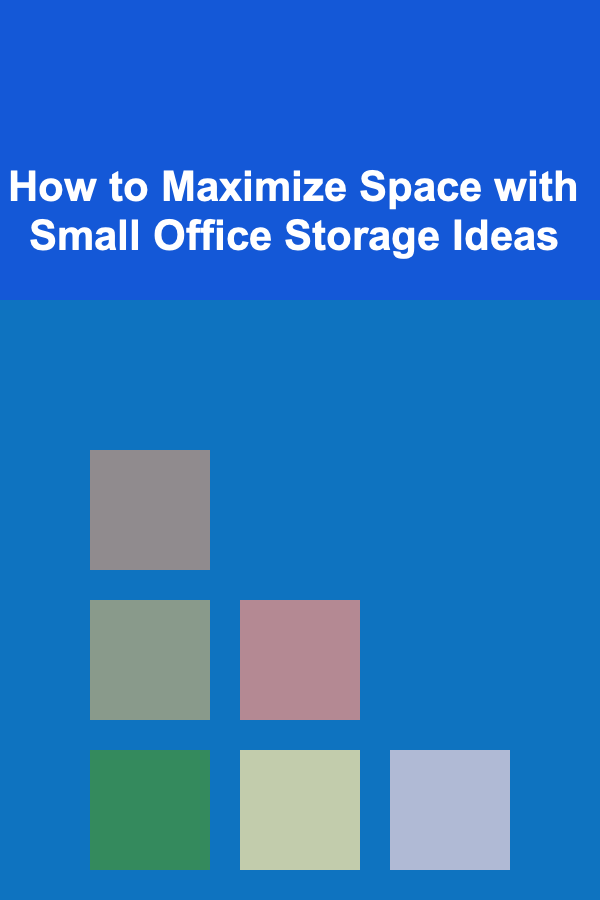
How to Maximize Space with Small Office Storage Ideas
ebook include PDF & Audio bundle (Micro Guide)
$12.99$6.99
Limited Time Offer! Order within the next:

In today's fast-paced world, many professionals find themselves working from small offices or home workspaces. Whether it's a corner of your living room or a dedicated small office, effective organization and storage are essential for maximizing productivity. A cluttered workspace can lead to distractions and impede workflow, making it vital to utilize storage solutions that optimize space. This comprehensive guide will explore various small office storage ideas, offering practical tips and strategies to create an efficient and organized workspace.
Understanding the Importance of Space Optimization
1. Enhanced Productivity
A tidy and organized office promotes focus and efficiency. When everything has its place and is easily accessible, you spend less time searching for items and more time on tasks that matter.
2. Reduced Stress Levels
Clutter can contribute to feelings of stress and overwhelm. By maximizing your office space and reducing disorder, you create a calming work environment that enhances well-being.
3. Improved Aesthetics
An organized office not only functions better but also looks more appealing. A visually pleasing environment can inspire creativity and motivation, boosting overall job satisfaction.
4. Better Time Management
An optimized workspace allows for smoother workflows and streamlined processes. Efficiency increases when tools and materials are within easy reach, leading to improved time management.
5. Maximum Use of Available Space
In small offices, every inch counts. By employing clever storage solutions, you can make the most of limited space without sacrificing functionality or comfort.
Assessing Your Office Space
Before implementing storage solutions, it's essential to assess your current office layout and identify specific needs. Here's how to get started:
Step 1: Evaluate Your Current Setup
Begin by analyzing your existing workspace. Take notes on what works well and what doesn't:
- What furniture do you currently use?
- Where do you typically store supplies?
- Are there areas that feel cramped or disorganized?
Step 2: Measure Your Space
Measure your office dimensions, including walls, corners, and available floor space. Consider these measurements:
- Height: Assess how much vertical space is available for shelving or cabinets.
- Width: Identify how much horizontal space exists for desks and other furniture.
- Depth: Ensure that any furniture you purchase fits comfortably within the space without feeling crowded.
Step 3: Determine Your Storage Needs
Identify the types of items you need to store in your office, such as:
- Office Supplies: Pens, paper, notebooks, etc.
- Technology: Laptops, chargers, external drives.
- Reference Materials: Books, manuals, reports.
- Personal Items: Decorative items, photos, plants.
Step 4: Define Your Workflow
Consider how you work and the resources you require at your fingertips. Think about how often you use specific items and their ideal storage location:
- Frequently Used Items: Should be easily accessible.
- Infrequently Used Items: Can be stored away in cabinets or higher shelves.
Creative Small Office Storage Solutions
Now that you've assessed your space and identified your needs, let's explore practical and creative storage solutions tailored for small offices.
1. Utilize Vertical Space
Shelving Units
Vertical shelving units are one of the most effective ways to maximize storage in small offices.
- Floating Shelves: Install floating shelves above your desk or work area to display books, decorative items, or office supplies.
- Tall Bookcases: Choose tall bookcases instead of wide ones to make the most of vertical space while retaining accessibility.
- Corner Shelves: Corner shelves can fit awkward spaces while providing additional storage.
Wall-Mounted Organizers
Wall-mounted organizers can keep essential supplies within arm's reach while freeing up desk space.
- Pegboards: Hang pegboards to store frequently used tools and supplies. Customize hooks and containers for pens, scissors, and sticky notes.
- Magnetic Strips: Use magnetic strips to hold metal items like scissors and clips, keeping them organized and visible.
2. Multi-Functional Furniture
Selecting multi-functional furniture can significantly enhance the usability of a small office.
Desks with Built-In Storage
Choose desks that offer built-in storage, such as drawers or shelves underneath. This helps eliminate clutter on your desktop while keeping supplies easily accessible.
Folding Tables and Desks
Folding tables or desks can provide flexibility, allowing you to create more space when needed. Collapse them when not in use to open up the area for other activities.
Ottomans with Hidden Storage
Ottomans that double as storage solutions can store items like extra office supplies or documents. They can also serve as seating or footrests.
3. Clear Storage Containers
Using clear storage containers can enhance visibility and organization.
Stackable Bins
Stackable bins allow you to utilize vertical space while keeping items organized. Label each bin to quickly identify contents without rummaging through them.
Drawer Organizers
Drawer organizers can help categorize office supplies within drawers. Use dividers to separate different types of items, ensuring easy access and preventing clutter.
4. File Organization Systems
Maintaining a neat filing system is crucial in a small office to keep documents organized and accessible.
Vertical File Folders
Vertical file holders can save space while keeping documents upright. Label folders clearly and organize them by category or project.
Hanging File Systems
If your office has a limited surface area, consider using hanging file systems mounted on walls or inside cabinets to store important paperwork.
5. Under-Desk Solutions
Maximize the space under your desk with creative storage options.
Under-Desk Drawers
Install under-desk drawers that slide out easily, perfect for storing small supplies or personal items. These drawers keep your workspace clean and uncluttered.
Rolling Carts
Utilize rolling carts beneath your desk for added storage. They can hold files, art supplies, or technology, and can be pulled out when needed.
6. Utilize Closet Space
If your office has a closet, consider converting it into a storage haven.
Closet Organizer Systems
Install adjustable shelving, hanging rods, and cubbies within the closet to maximize organization. Use labeled bins or baskets for smaller items.
Door-Mounted Organizers
Make use of the inside of the closet door by installing door-mounted organizers for smaller supplies like stationery, cleaning supplies, or snacks.
7. Regularly Declutter
Regular decluttering is essential for maintaining an organized workspace.
Routine Cleanouts
Schedule monthly cleanouts to remove unnecessary items from your office. Discard outdated documents, broken tools, or supplies you no longer use.
Seasonal Review
Conduct seasonal reviews of your office supplies. Reassess what you use versus what takes up space and adjust accordingly.
Designing an Efficient Workflow
Creating an efficient workflow is just as important as selecting storage solutions. Here are some strategies to ensure your workspace operates smoothly.
1. Prioritize Accessibility
Arrange your space so that frequently used items are easy to access. This may involve placing essential supplies within arm's reach and utilizing drawer dividers for quick retrieval.
2. Create Zones
Designate specific zones for different tasks or categories of items:
- Work Zone: Keep your desk clear for workspace essentials.
- Storage Zone: Allocate shelving or cabinets for storing supplies and documents.
- Tech Zone: Establish a section for technology-related items like chargers, headphones, and devices.
3. Implement a Color-Coding System
Using color coding can streamline organizational efforts. Assign colors to categories---such as red for urgent documents, blue for personal items, and green for office supplies---to simplify identification and sorting.
4. Establish a Routine
Create a daily routine for tidying up your workspace. Spend a few minutes at the end of each workday organizing supplies, returning items to their designated spots, and removing clutter.
Leveraging Technology for Organization
In addition to physical storage solutions, technology can play a significant role in enhancing organization and efficiency.
1. Digital Document Management
Use document management software to digitize important papers and reduce physical clutter. Scan and store documents electronically, making them searchable for quick access.
2. Cloud Storage Solutions
Utilize cloud storage services to back up important files and access them from anywhere. This keeps your data secure while reducing reliance on physical storage.
3. Productivity Apps
Leverage productivity apps to manage tasks and projects efficiently. Apps like Trello, Asana, or Todoist can help you stay organized and prioritize your workload.
4. Virtual Collaboration Tools
Adopt virtual collaboration tools like Slack or Microsoft Teams to communicate with colleagues effectively. Centralizing communication reduces the need for physical notes or papers.
Maintaining Your Small Office
Once you've established an optimized workspace, maintaining it is critical to ensure continued efficiency. Here are some tips for upkeeping your small office organization:
1. Commit to Regular Maintenance
Set aside time weekly or bi-weekly to tidy up your workspace. Regular maintenance prevents clutter from accumulating and allows for timely adjustments as needs change.
2. Stay Adaptive
As your work evolves, be open to changing your setup. Adapt storage solutions based on current projects, workloads, or changes in priorities.
3. Involve Others
If you share your office with coworkers or family members, involve them in maintaining order. Establish shared responsibility for keeping the space organized.
4. Celebrate Achievements
Recognize accomplishments and take the time to celebrate milestones. Keeping your workspace organized can foster a sense of pride and motivation.
Conclusion
Maximizing space in a small office requires thoughtful planning and strategic implementation of storage solutions. By assessing your specific needs, investing in multi-functional furniture, and leveraging both physical and digital organizational tools, you can create a productive and inspiring workspace.
Through careful arrangement, decluttering, and regular maintenance, you can turn even the smallest office into an efficient environment where creativity and productivity thrive. Embrace the possibilities, and transform your small office into a well-organized haven tailored to your work style and aspirations. With these storage ideas, you'll find that you can achieve a clutter-free, functional workspace, regardless of size.
Reading More From Our Other Websites
- [Home Maintenance 101] How to Store Appliances Properly When Not in Use
- [Metal Stamping Tip 101] Common Metal Stamping Tooling Mistakes and How to Avoid Them
- [Home Party Planning 101] How to Plan a Themed Party That Will Wow Your Guests
- [Home Rental Property 101] How to Make the Most of Apartment Rentals with a Community Dog Wash Station: A Dog-Friendly Guide
- [Personal Care Tips 101] How to Mix Foundations to Get Your Perfect Shade
- [Home Party Planning 101] How to Organize a Fun Game Day Party at Home
- [Home Family Activity 101] How to Celebrate Family Milestones with Creative Activities
- [Tie-Dyeing Tip 101] Seasonal Style: How to Tie‑Dye Tote Bags for Every Holiday and Occasion
- [Personal Finance Management 101] How to Reassess Your Financial Goals During Major Life Events
- [Personal Care Tips 101] How to Compare Different Types of Toothbrushes

Unlocking the Potential of Passive Income with Deep Learning Projects
Read More
Why You Should Keep Organized Lists for Grocery Shopping
Read More
How to Understand Your Investment Portfolio
Read More
How To Create Engaging Email Newsletters for Your Small Business
Read More
Mastering 3D Printing for Artistic Sculptures: A Comprehensive Guide
Read More
10 Tips for Improving Your Hand Lettering Consistency
Read MoreOther Products

Unlocking the Potential of Passive Income with Deep Learning Projects
Read More
Why You Should Keep Organized Lists for Grocery Shopping
Read More
How to Understand Your Investment Portfolio
Read More
How To Create Engaging Email Newsletters for Your Small Business
Read More
Mastering 3D Printing for Artistic Sculptures: A Comprehensive Guide
Read More